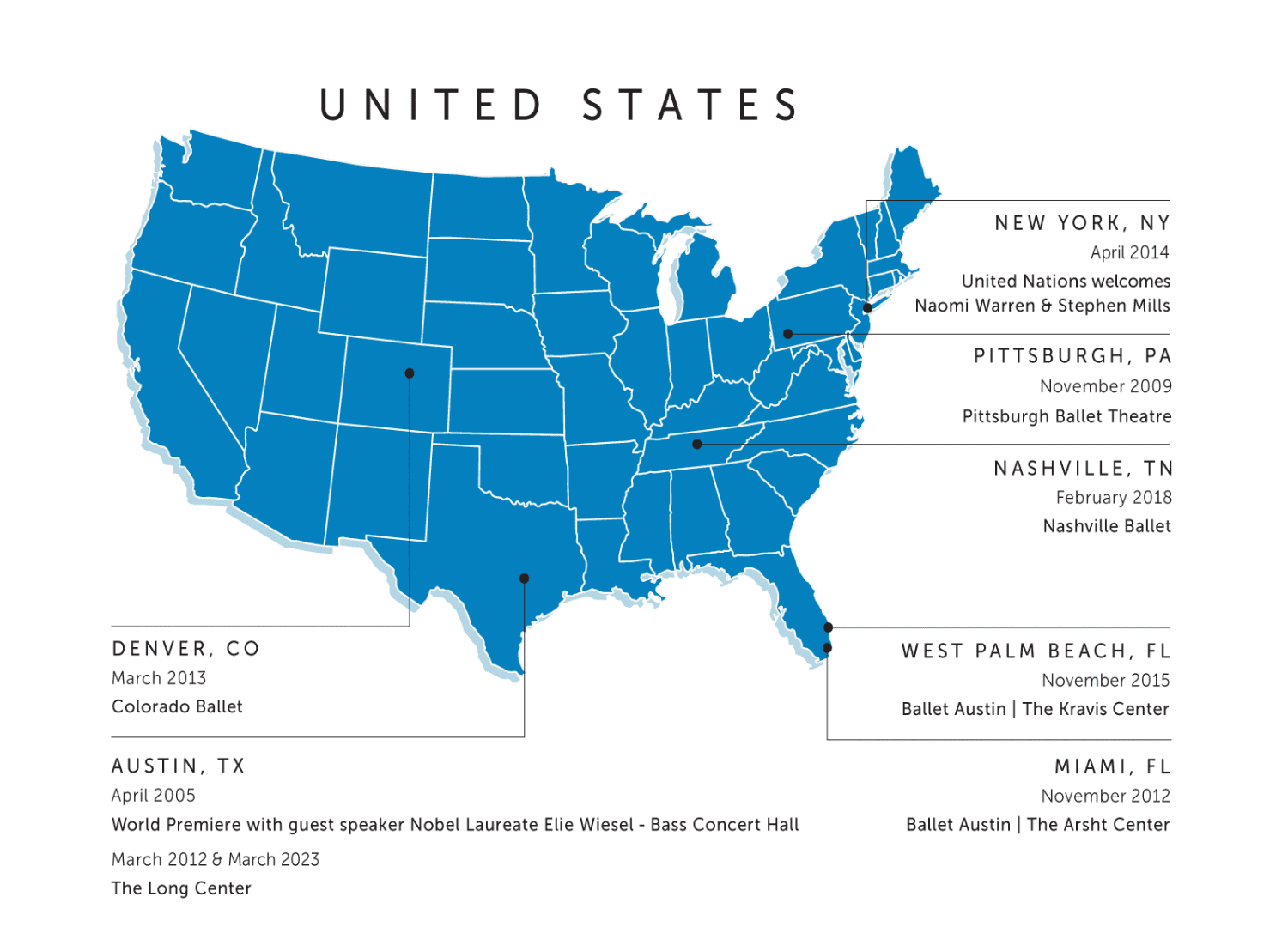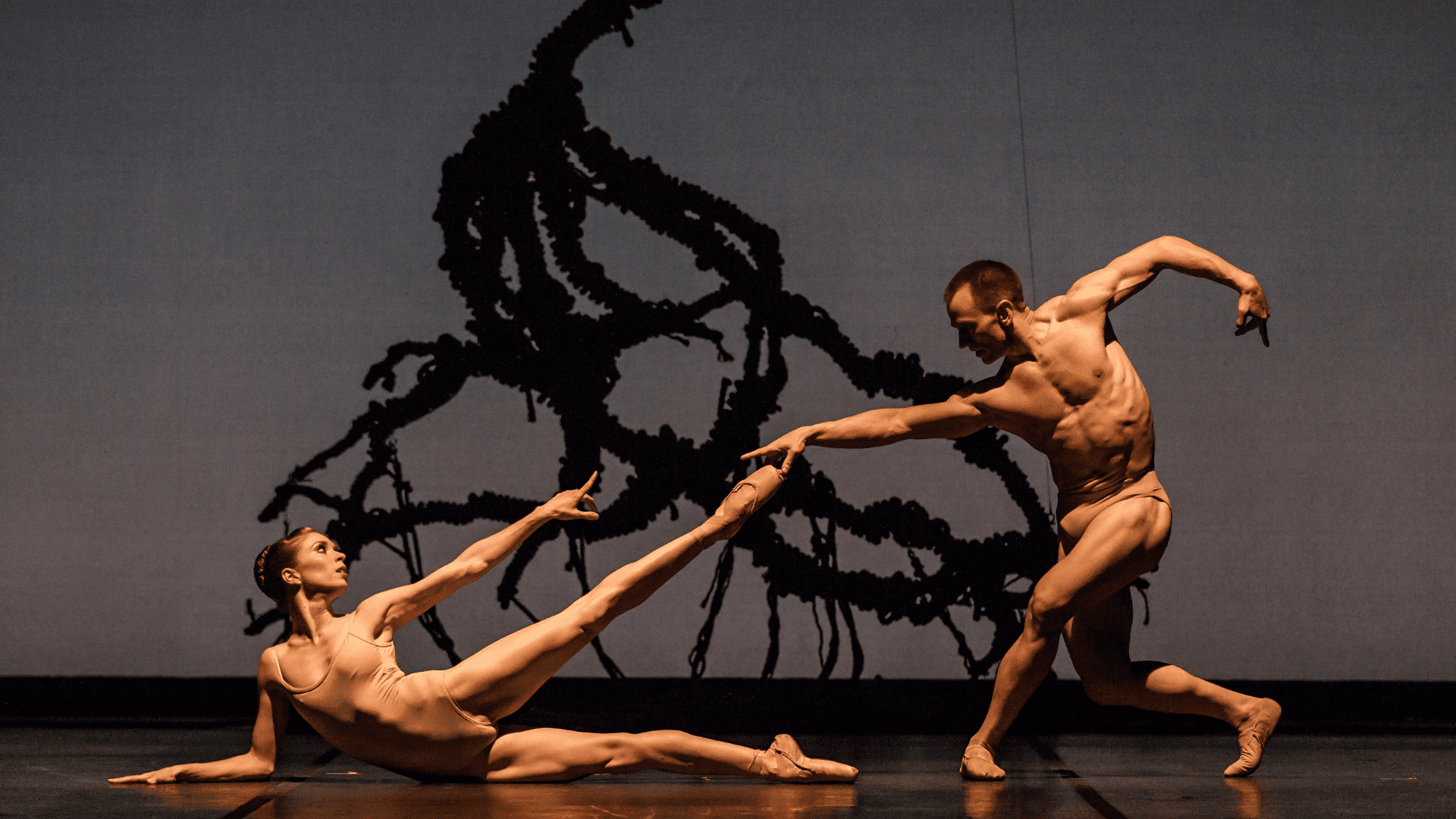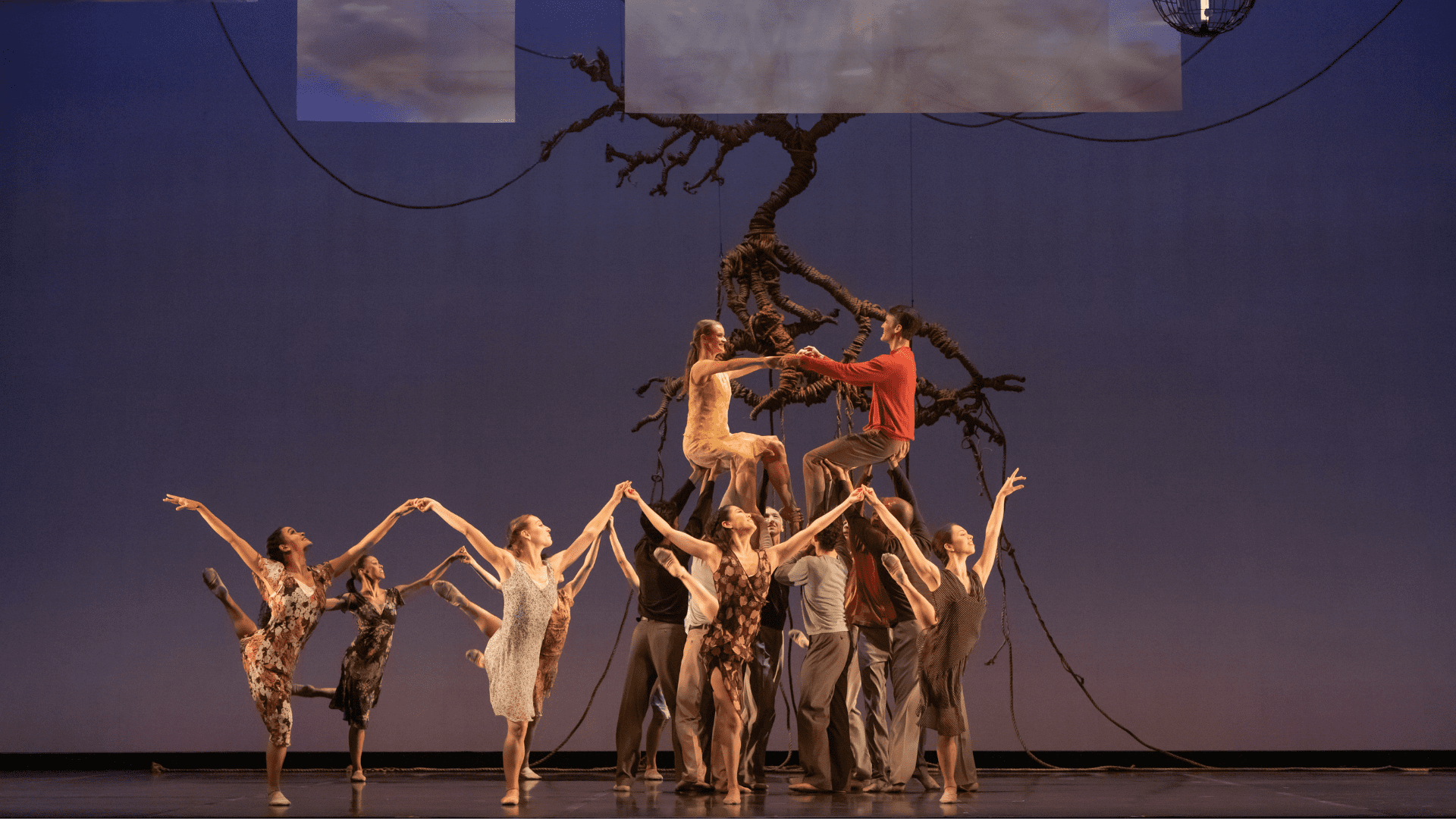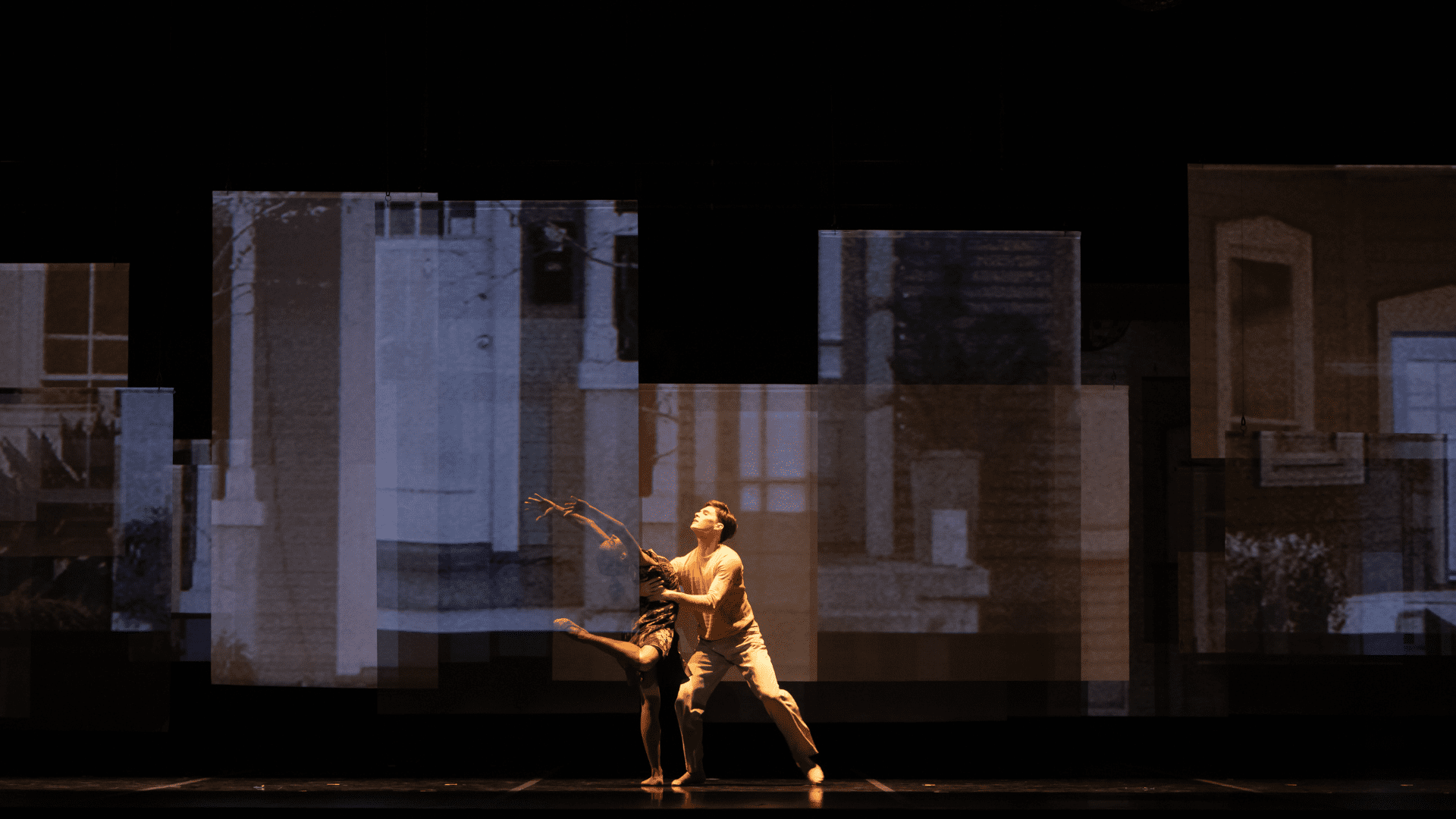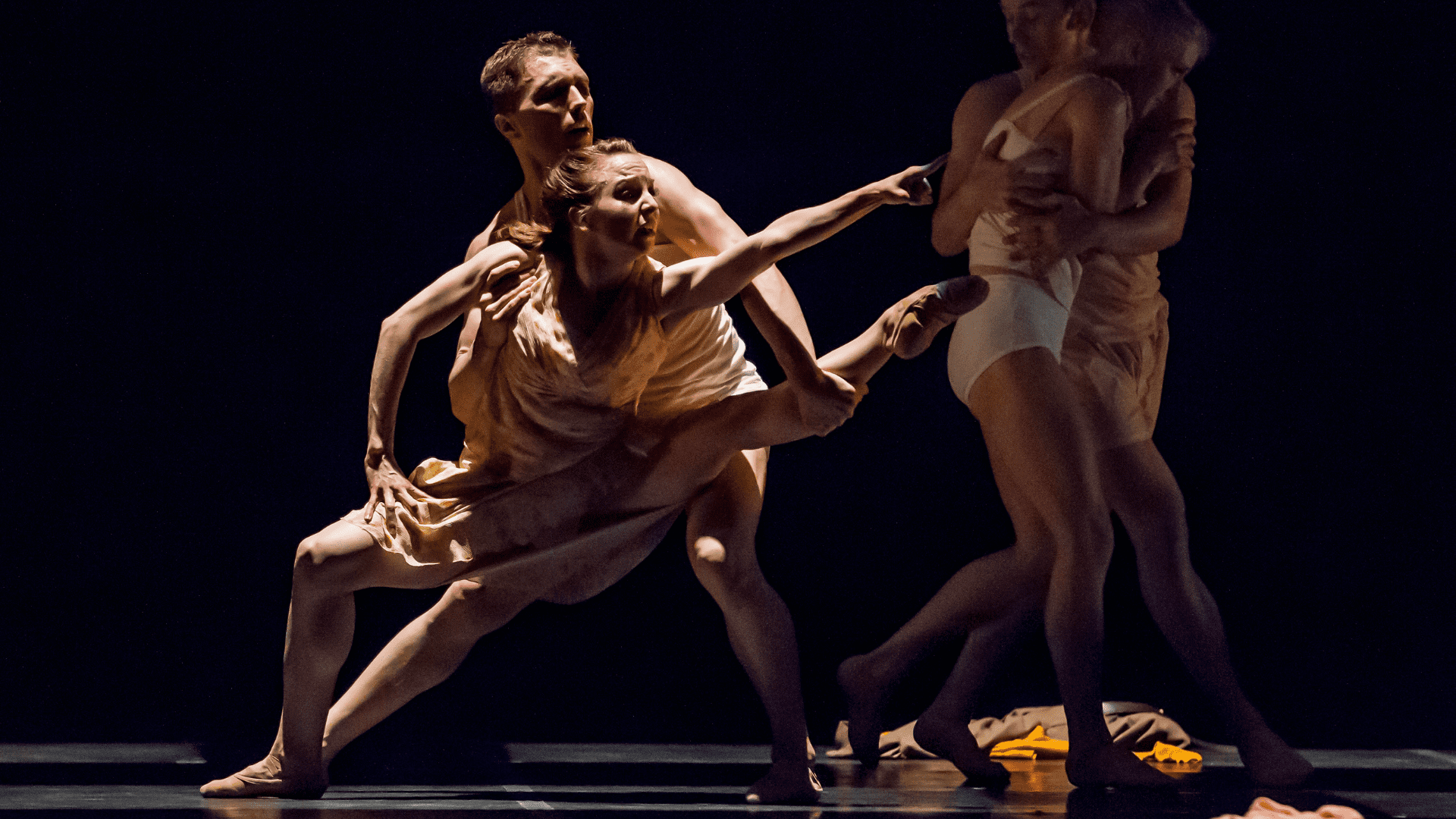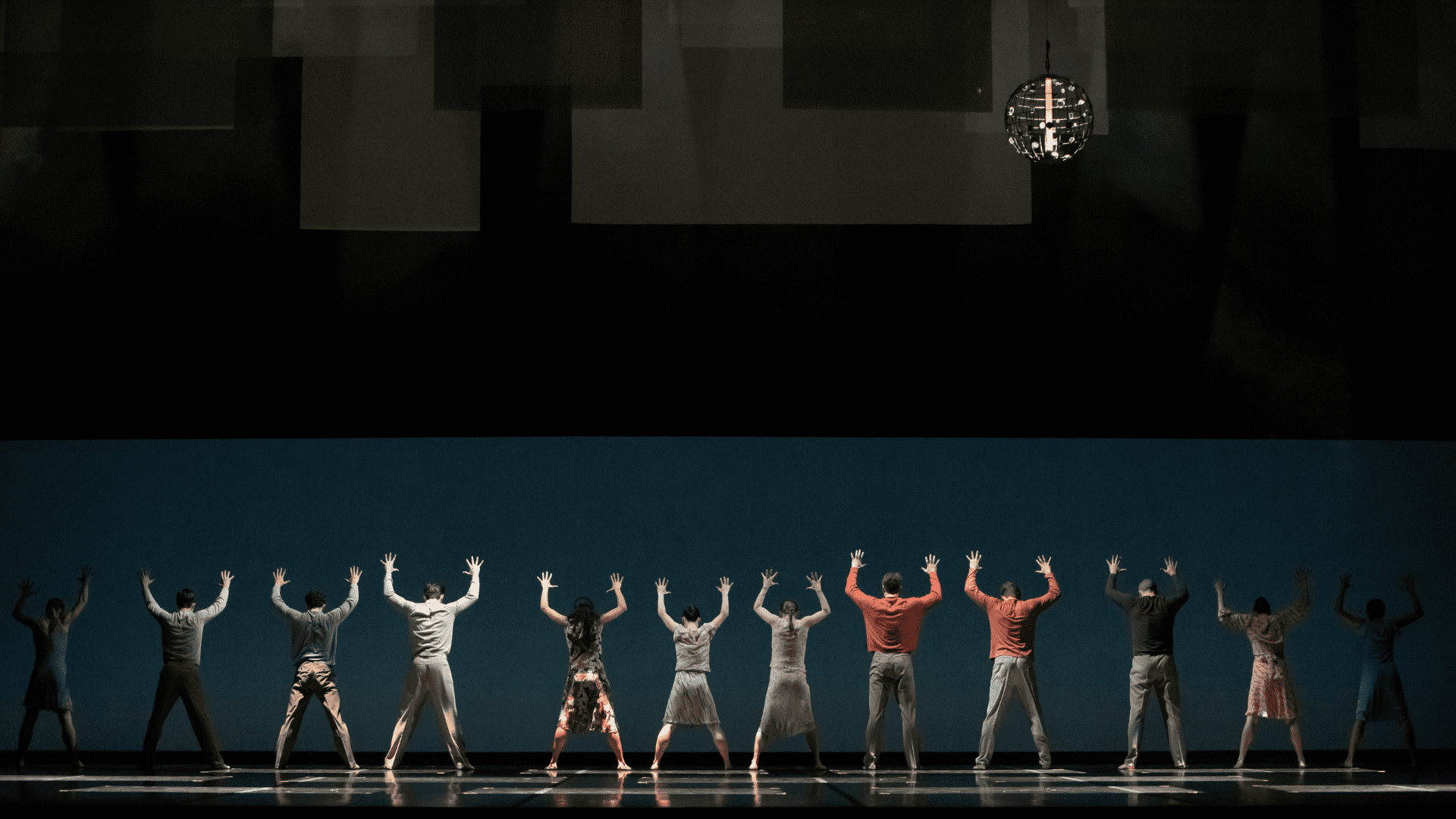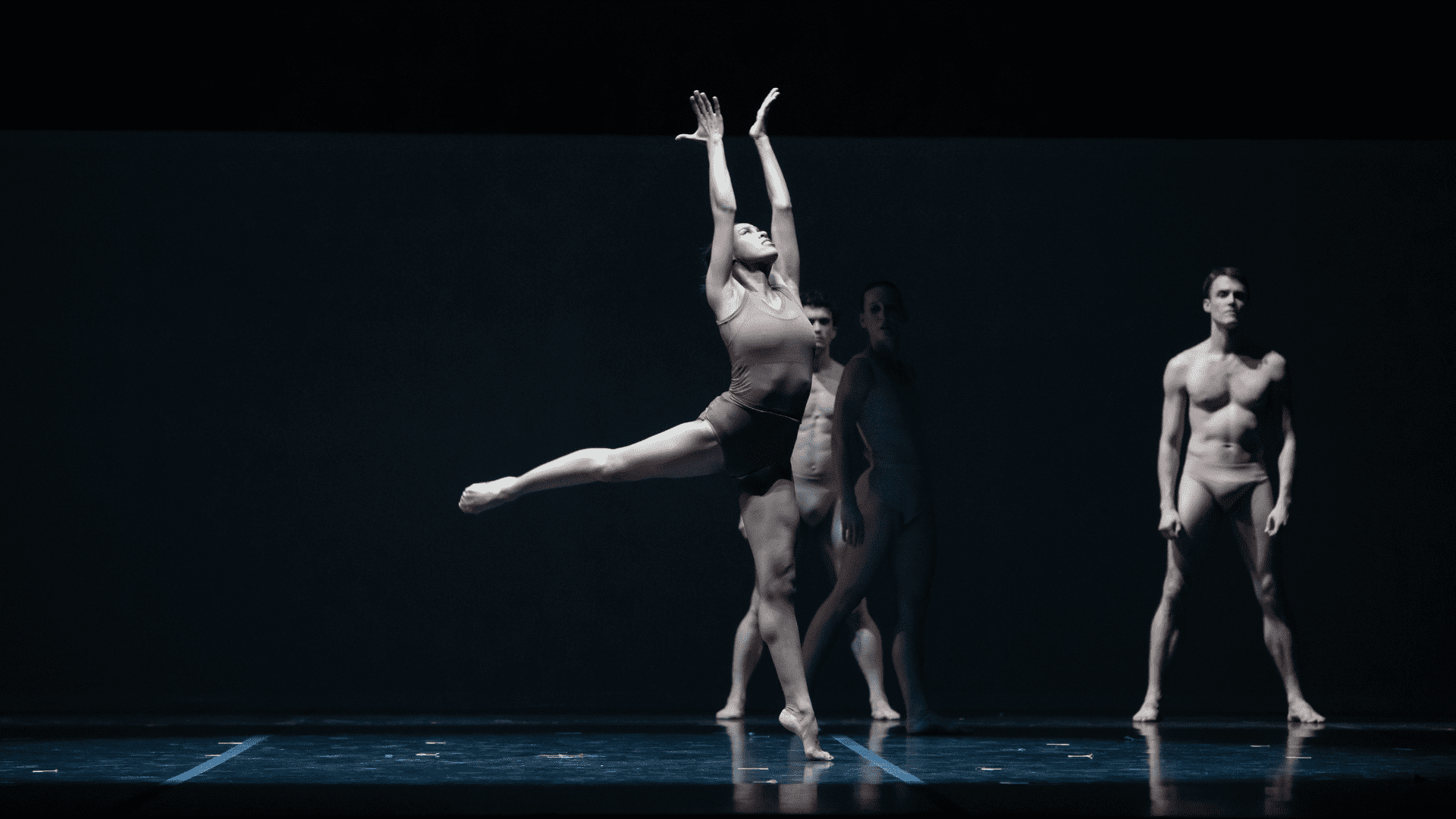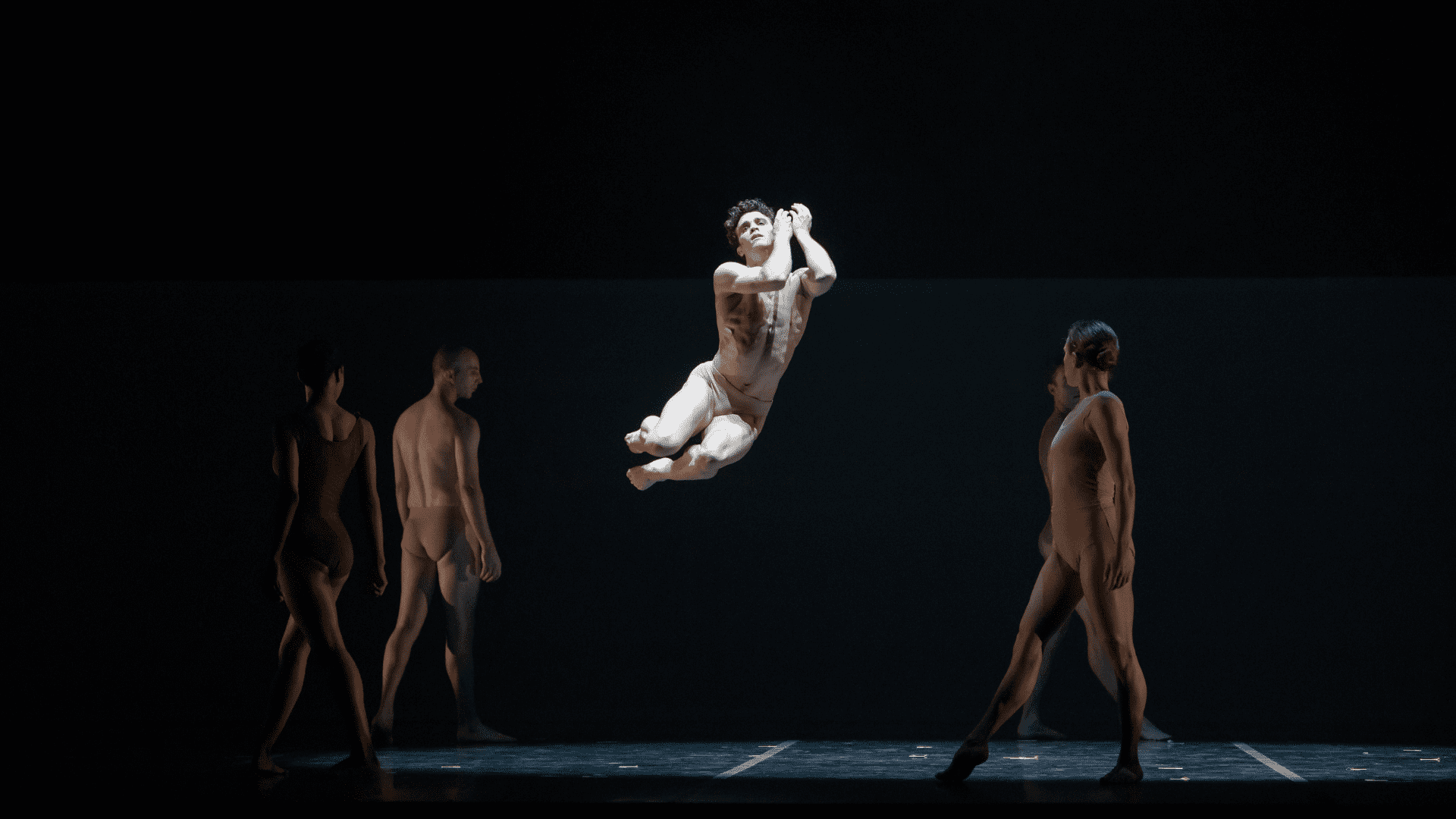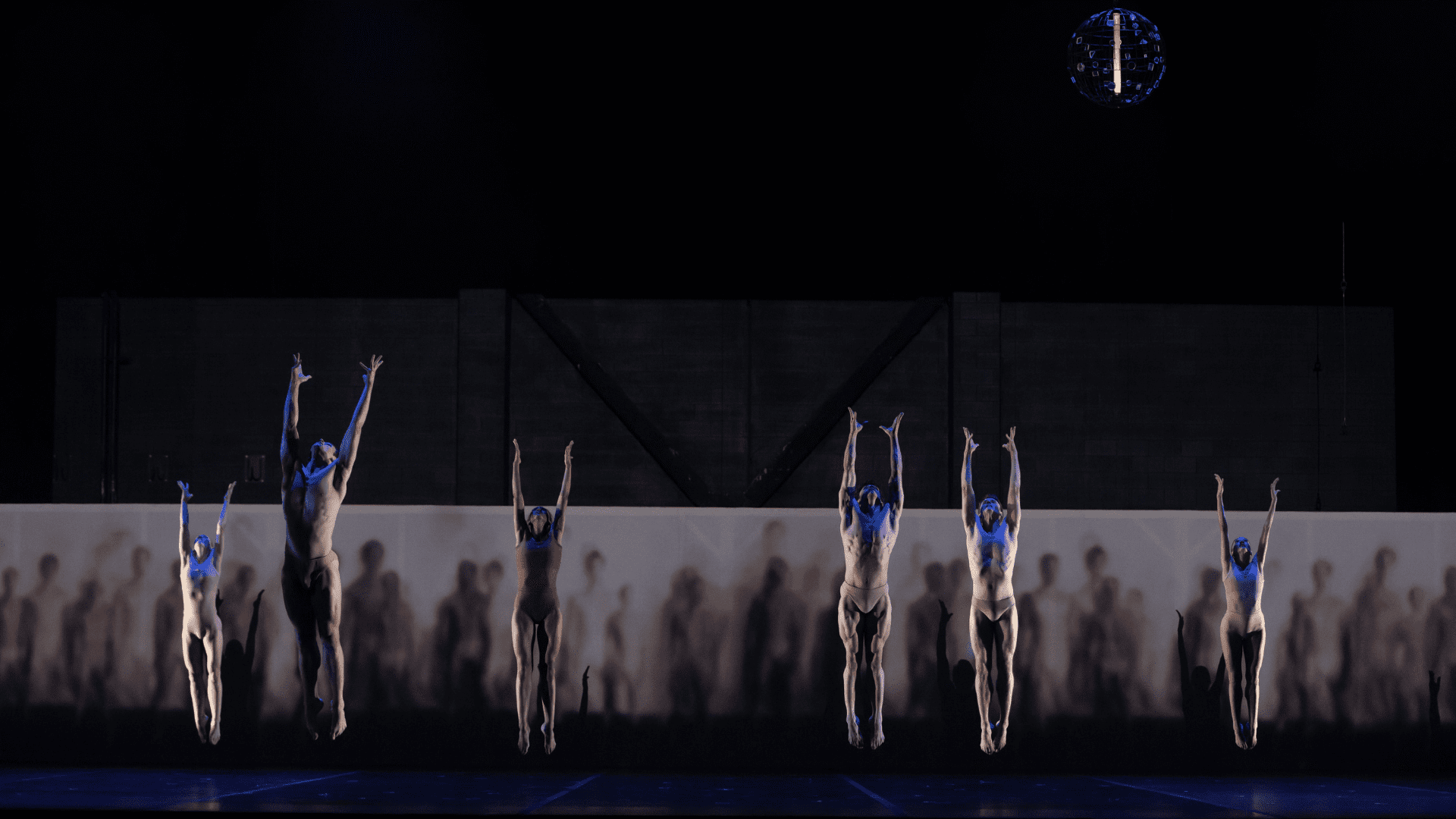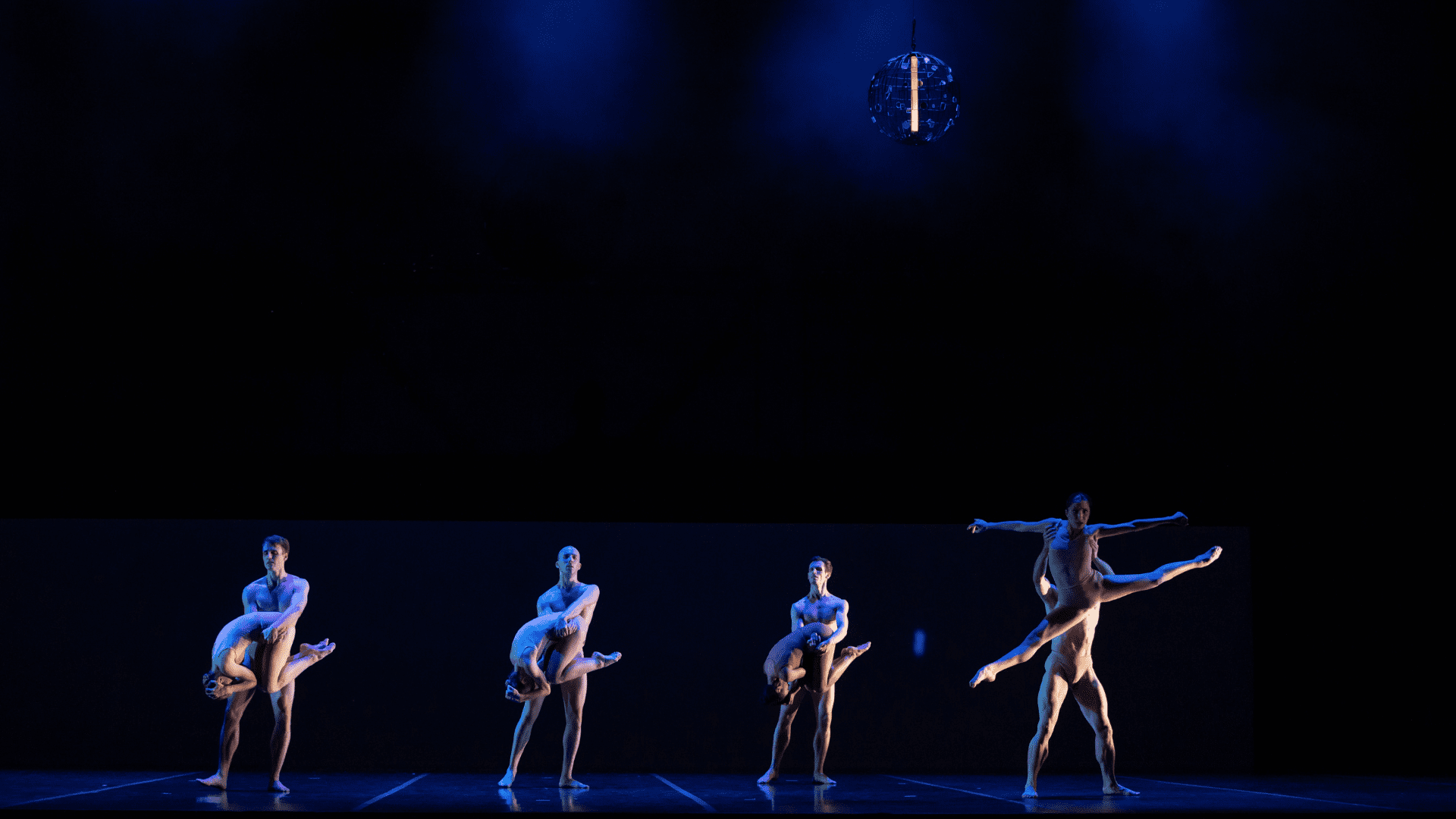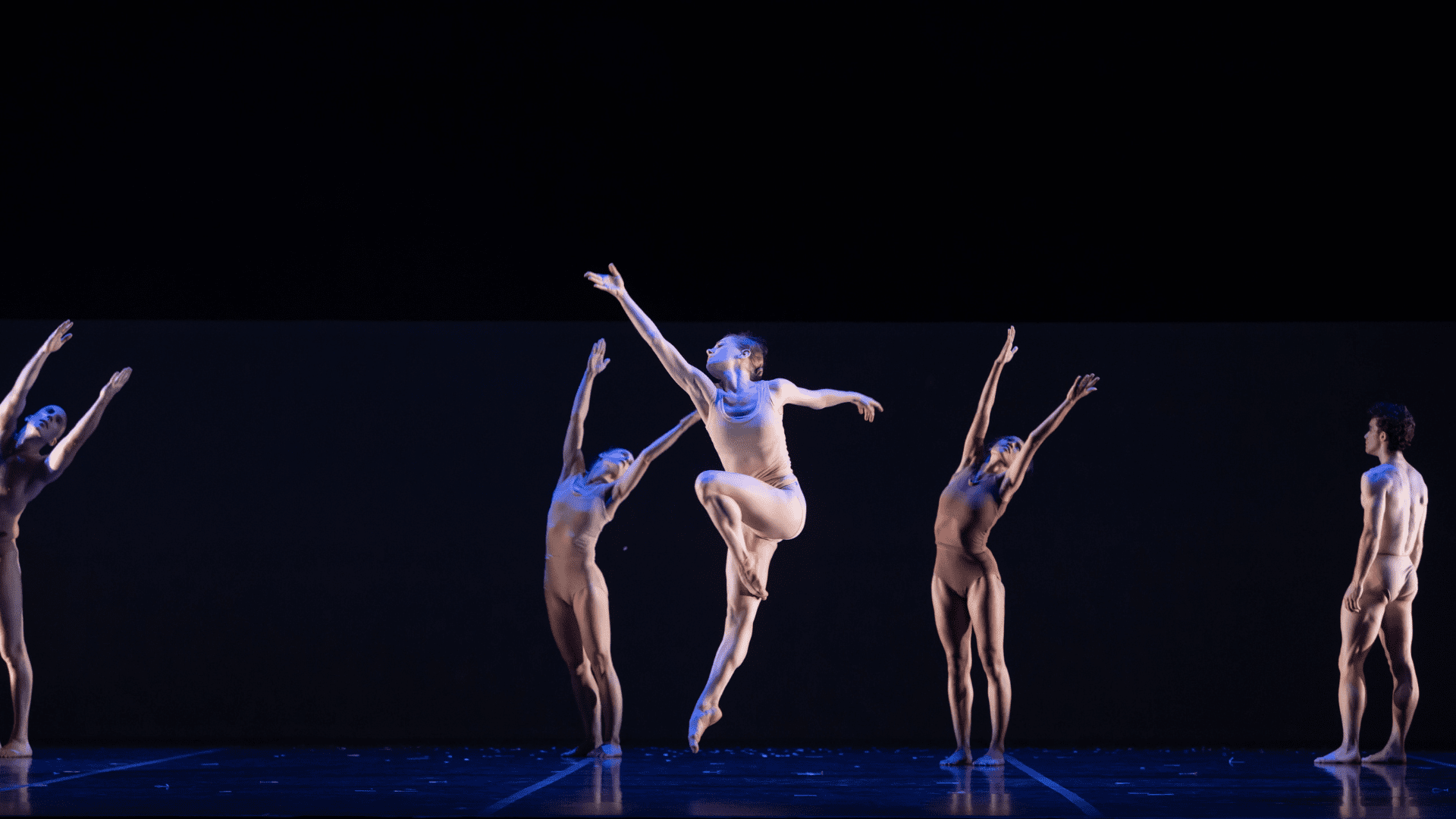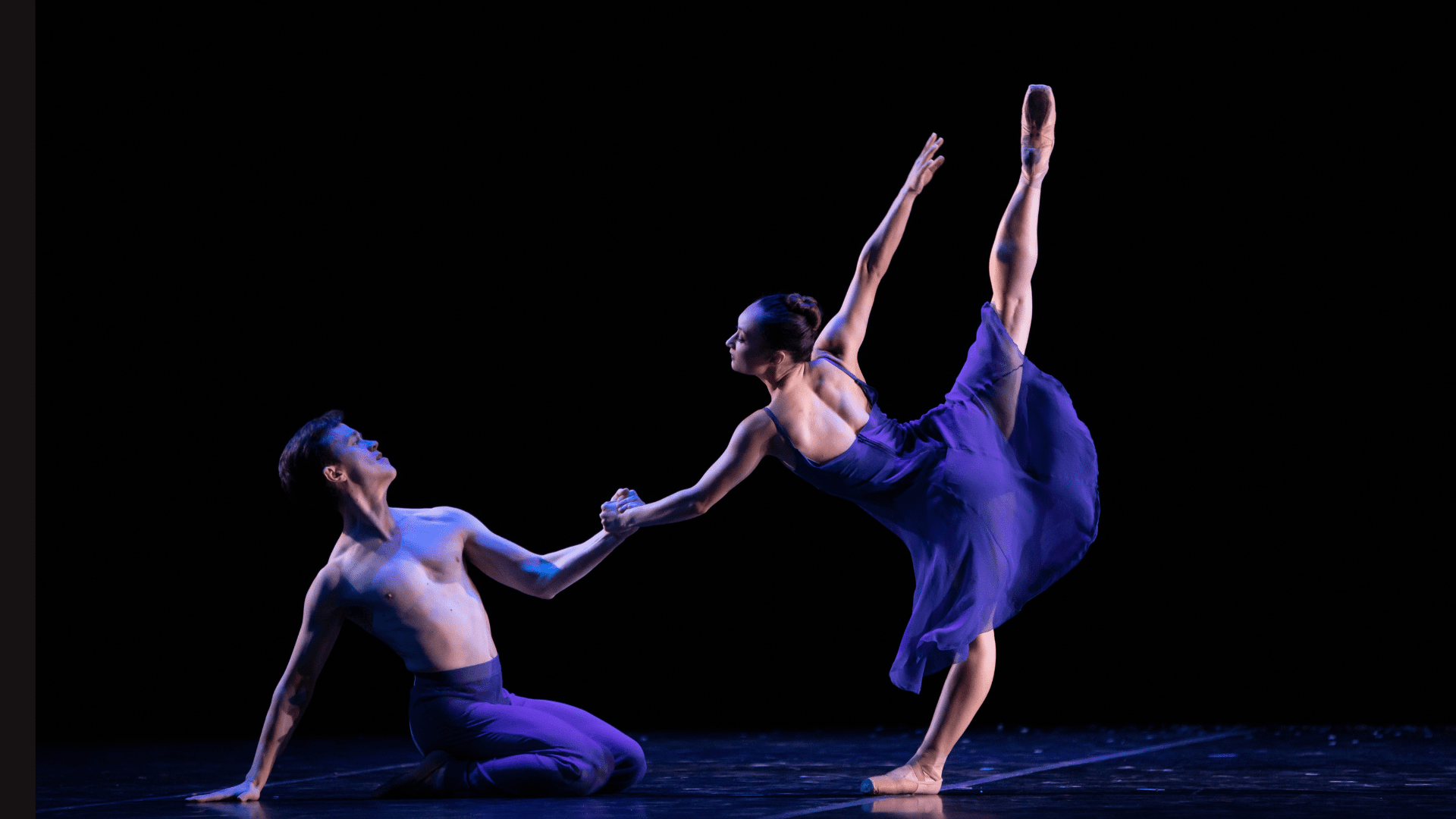Light / The Holocaust & Humanity Project
IN OUR DARKEST TIMES, IT IS HOPE THAT PUSHES US FORWARD
Illuminated through the powerful story of Holocaust survivor Naomi Warren (1920-2016), Stephen Mills’ Light / The Holocaust & Humanity Project takes the audience on a journey that shares Naomi’s story while making relevant connections to the present, told through the lens of dance. This full-length contemporary dance work follows Naomi’s path from a beautiful family with a rich culture and traditions, to utter dehumanization…and all along the way, we feel Naomi’s courage, resilience, and hope.
Choreographed and designed by Stephen Mills, LIGHT has been a project of his for the past 20 years. The production has toured both nationally and internationally, featuring both the 84-minute dance and community-wide discussions focused on the protection of human rights against bigotry and hate. The music is composed of works by a number of notable contemporary writers. The décor and dress is of today, and spare. The story of “never again” is a warning of which we must always be mindful and diligent concerning the protection of human rights against bigotry and hatred.
“I am grateful to Naomi Warren and the many survivors who shared their testimonies during the creation of this work. I am forever changed by this knowledge and hope that by my sharing Naomi’s story, others will be affected to fight indifference and intolerance when witnessed.” – Stephen Mills
CONCEPT & CHOREOGRAPHY: Stephen Mills
SET/COSTUME DESIGN: Christopher McCollum
LIGHTING DESIGN: Tony Tucci
MUSIC: Steve Reich, Evelyn Glennie, Michael Gordon, Arvo Pärt, Philip Glass
MEDIA DESIGN: Action Figure
RUNTIME: 84 minutes without intermission

Naomi Warren serves as the inspiration behind the story of survival and triumph of the human spirit in Ballet Austin’s Light / The Holocaust & Humanity Project.
Naomi Warren grew up in Wolkowysk, a small city in Eastern Poland. In 1939, the war broke out and by the summer of 1941, the Nazi army invaded Poland. The Nazis very quickly began systematically isolating, interning and murdering the Jewish population. Naomi and many family members were rounded up and sent to Auschwitz-Birkenau in January of 1942. Arriving at the camp, Naomi was torn from her family. Her mother was selected for immediate liquidation. During her time in the death camp, she lost her husband, sister-in-law, and others. Naomi survived three years at Auschwitz, was transferred to Ravensbruck and was eventually liberated from Bergen-Belsen.
Read MoreCourtesy of the Holocaust Museum Houston | Photo by Hannah Neal
PROJECT TIMELINE
BEHIND THE SCENES
Light / The Holocaust & Humanity Project, made its world premiere in Austin in April of 2005, and in 2006 received the Anti-Defamation League’s Audrey & Raymond Maislin Humanitarian Award. Since that time, 8 other cities across the US and around the world hosted Stephen Mills’ dance work and the accompanying collaborative community dialogue focused on the protection of human rights against bigotry and hatred. In the fall of 2013, LIGHT made its international debut during a three-city tour across Israel. In 2014 Stephen and Naomi were invited to speak about LIGHT at the United Nations, New York City. While we lost Naomi on October 2, 2016 at 96 years old, this work in her honor continues to share her message of hope.
Click to enlarge photos.
Voices on Anti-Semitism Podcast from The United States Holocaust Memorial Museum
In 2013, the United States Holocaust Memorial Museum (USHMM) invites Stephen Mills to speak as part of the Voices On Anti-Semitism—U.S. Holocaust Memorial Museum Podcast Series. The USHMMA is a living memorial to the Holocaust and inspires citizens and leaders worldwide to confront hatred, prevent genocide and promote human dignity.
United Nations Radio Interview
In May of 2014, Stephen Mills is invited to participate in a discussion with the United Nations on the topic of how to communicate about the Holocaust through art.
TEDxSMU – Stephen Mills – Light/The Holocaust & Humanity Project
In November 2010, Stephen Mills is invited to record a TEDx Talk on his journey to create Light / The Holocaust & Humanity Project.
Section I:
Steve Reich (Tehillim, Track #1)
Life begins with man and woman, Adam and Eve. Civilization develops; families and cultures evolve to include a pattern of daily life and valued traditions, a wedding. As this section ends, change is imminent.
Section II:
Evelyn Glennie (Greatest Hits, Rhythm Song)
Those deemed “different” become exploited. What is familiar slowly disappears. People retreat from one another, beginning to socially isolate; to hide in hopes of survival.
Section III:
Michael Gordon (Weather Track #3)
No longer seen as individuals, life or death is determined by powers outside of their control. People are treated as property and transported to camps. Many do not survive the trip.
Section IV:
Arvo Pärt (Tabula Rasa)
How do relationships develop within confinement? The circle of life is complex with acts of kindness, rescue, survival, frustration and anger. We enter and leave alone.
Section V:
Philip Glass (Movement 2, Tyrol Concerto, performed by Dennis Russell Davies)
The final section represents the power of the human spirit to cling to hope. Survivors create new relationships; build families and careers, and productive lives.
FINDING LIGHT is a multi-faceted film, which at its core seeks to use dance as a convener of conversation around issues related to the protection of human rights against bigotry and hate. The film explores how the events of 9/11 led a dance choreographer to seek deeper meaning in his work. Illuminated through the story of Holocaust survivor Naomi Warren, the film takes the audience on a journey that is simultaneously situated in the past while making relevant connections to the present told through the lens of dance.
FINDING LIGHT is the culmination of the past 18 years of my life. In 2005, I was a dancer in the original production of Stephen Mills’ Light / The Holocaust & Humanity Project – the ballet upon which many themes of FINDING LIGHT is based. It was the only work in my dance career that resonated in ways I couldn’t fully grasp in my youth. The universal themes against bigotry and hatred were so much larger than myself that it was often overwhelming, but it also offered a sense of purpose and anchored my belief in why art matters.
As a filmmaker, the story of the creation of LIGHT was instantly something I wanted to share through the lens of film – but the right timing didn’t reveal itself until 2019. The catastrophic loss endured during the Holocaust can’t possibly be distilled down to a single book or film, but I truly believe in the worldwide effort to continue spreading awareness and keeping community dialogue open concerning social justice and human rights.
I had the privilege of knowing Naomi Warren – a Holocaust survivor and wonderful human being whose testimony is compelling, heartbreaking and inspiring all at once. Naomi’s story deserves to be heard and I am most humbled to be given the opportunity to continue her legacy through this film.
Paul Michael Bloodgood • Director / Producer
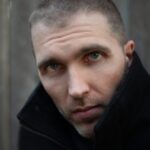
Official Selections & Accolades
VIDEO GALLERY
Videos by Paul Michael Bloodgood
PHOTO GALLERY
Photography by Tony Spielberg and Anne Marie Bloodgood
MEET THE ARTISTS
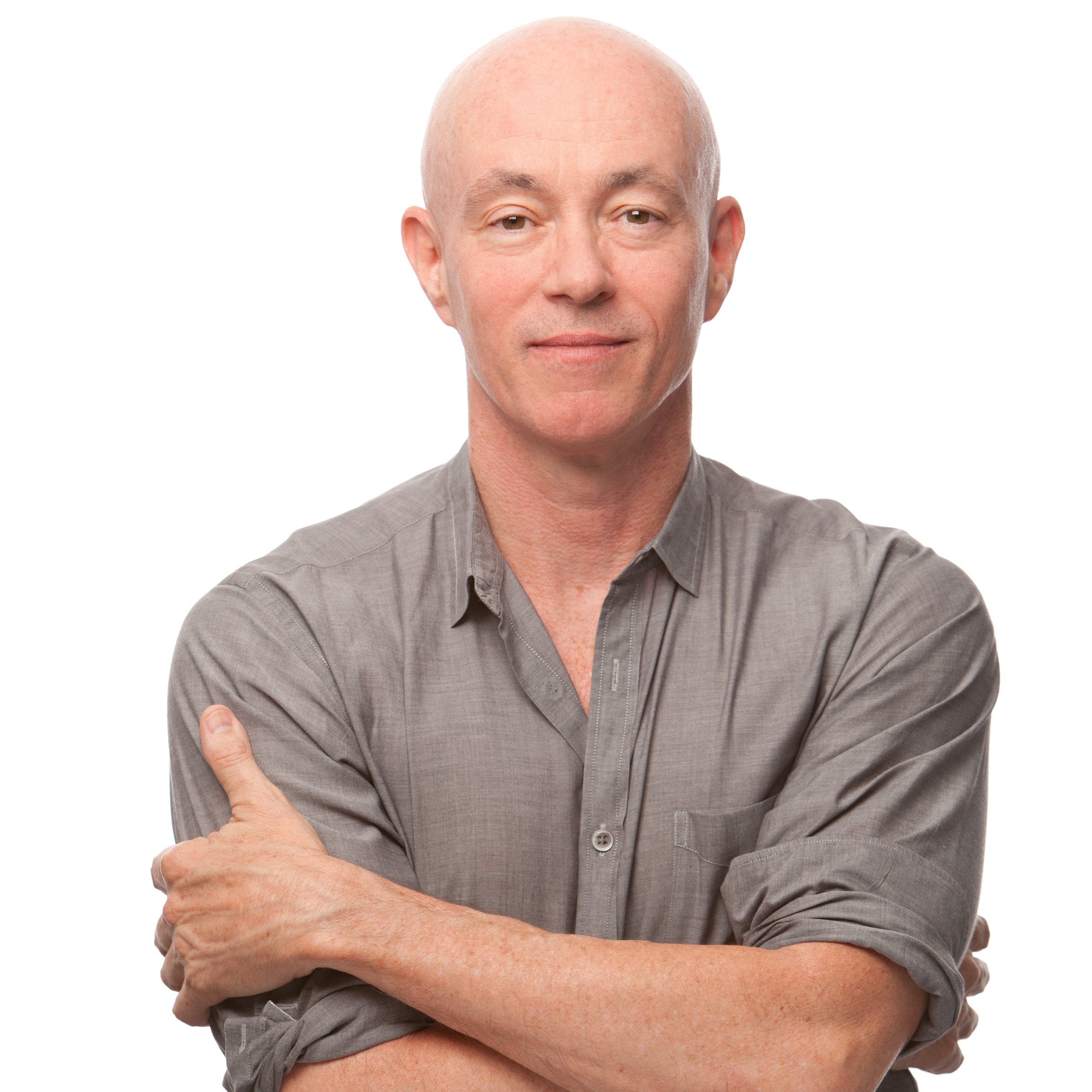
STEPHEN MILLS
Choreography
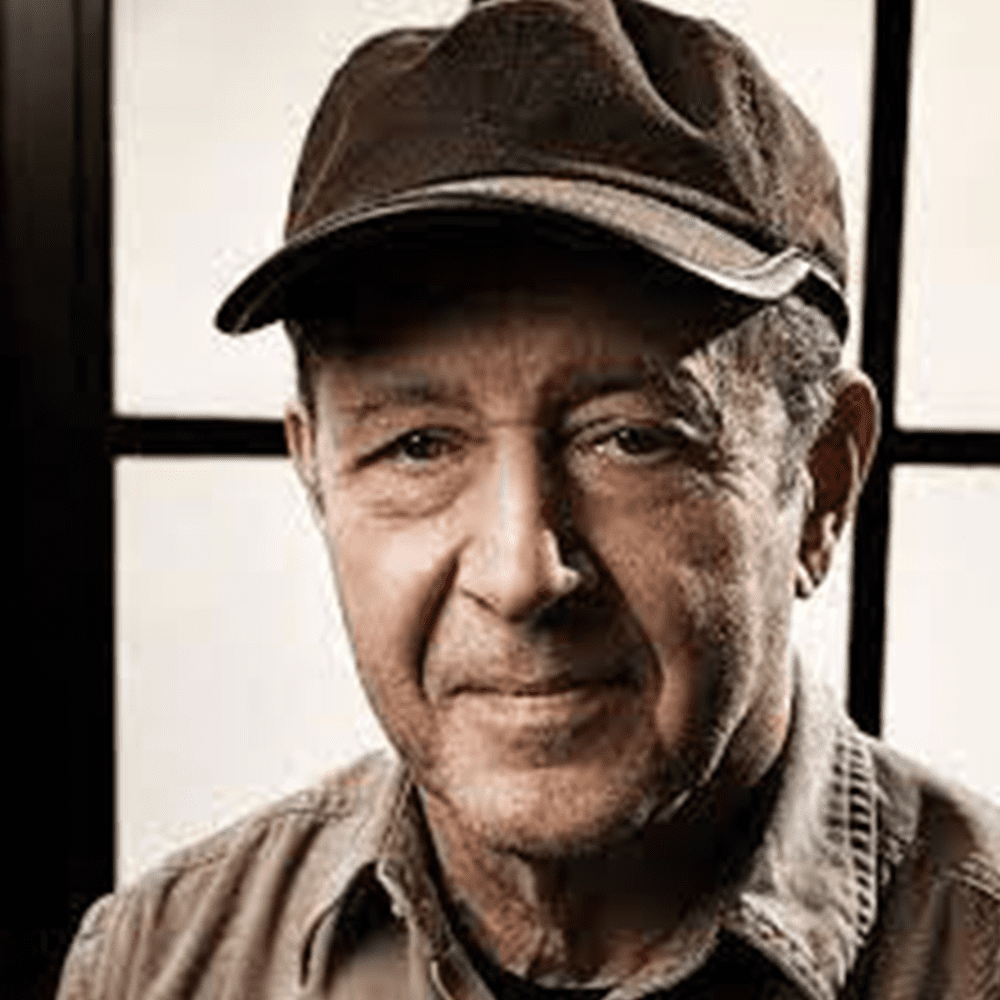
STEVE REICH
Music

EVELYN GLENNIE
Music
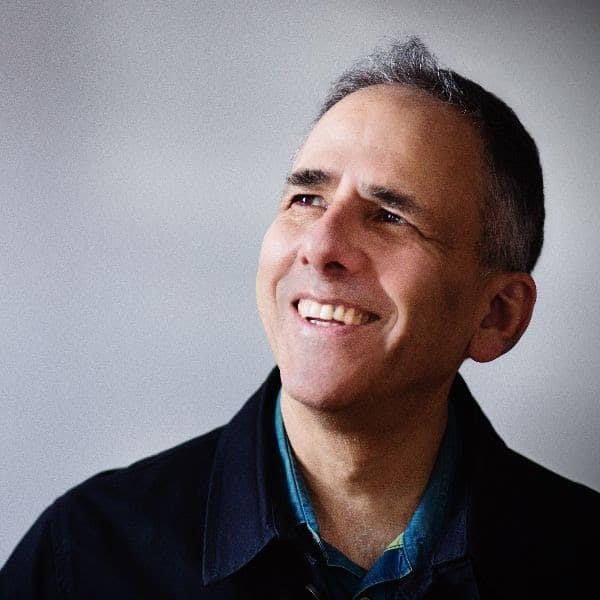
MICHAEL GORDON
Music
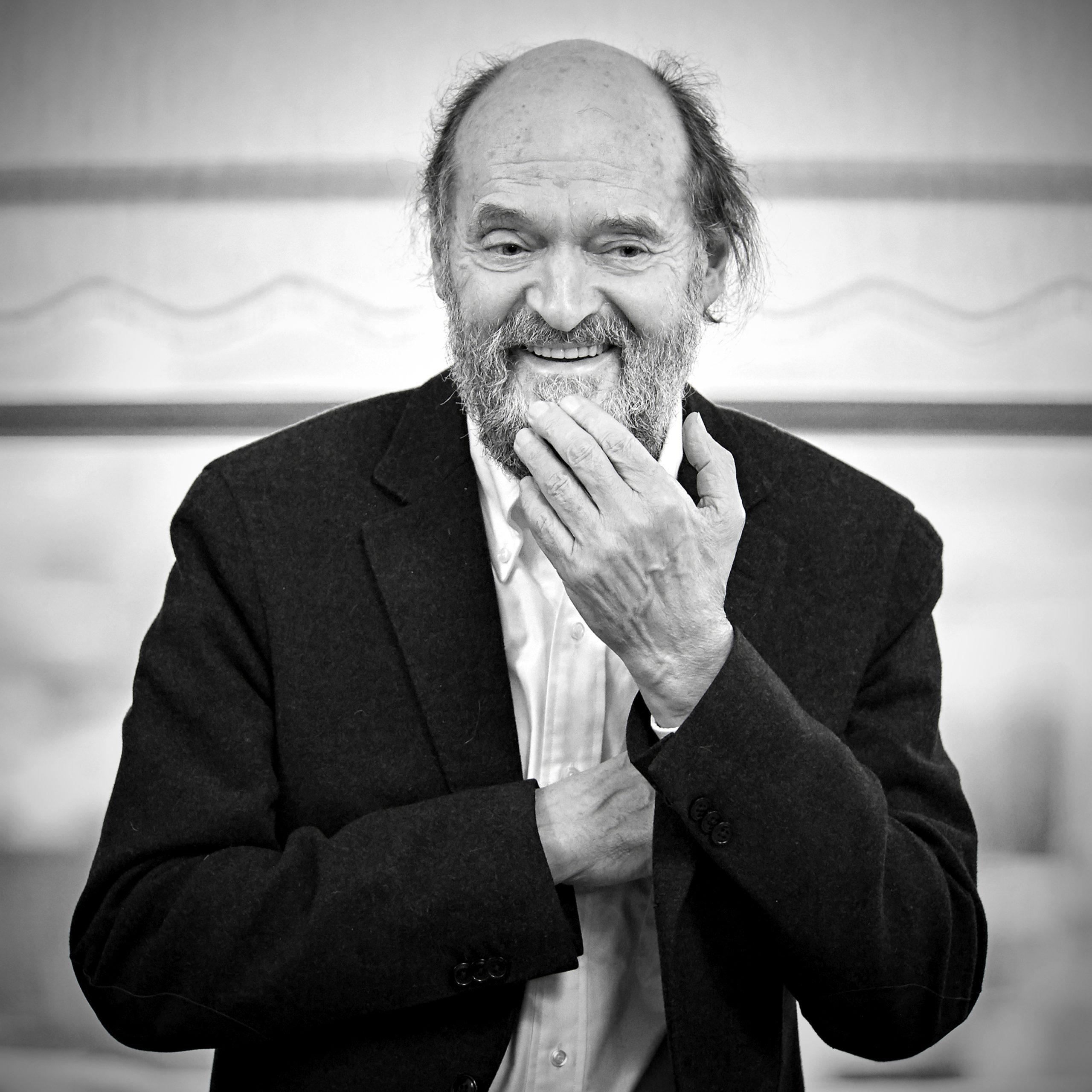
ARVO PÄRT
Music
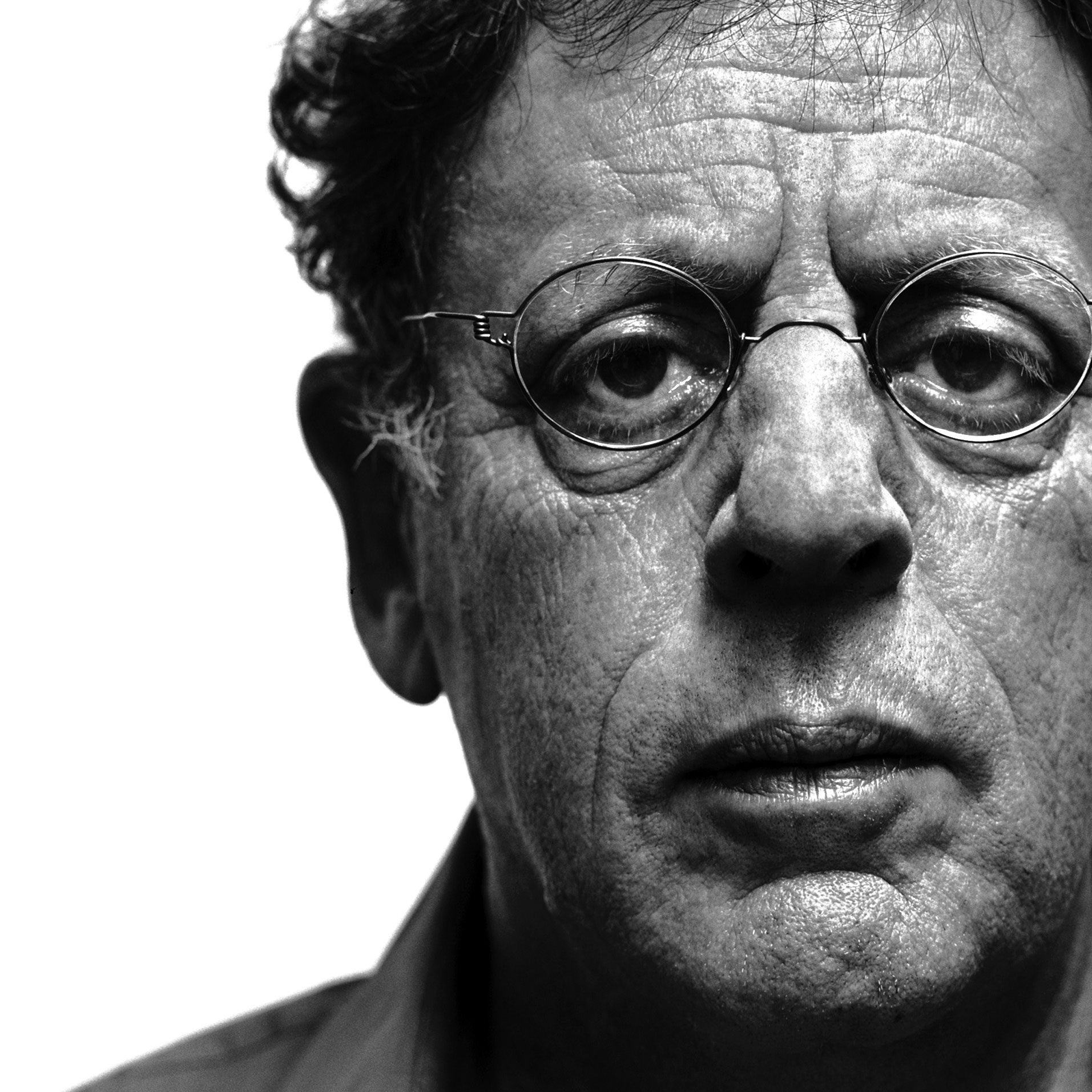
PHILIP GLASS
Music
Known for his innovative and collaborative choreographic projects, Stephen Mills has works in the repertoires of dance companies across the United States and around the world.
His international career began in 1998 after being chosen Prix d’Auteur at les Rencontres Chorégraphiques Internationales de Seine-Saint-Denis in Paris. In his inaugural season as Artistic Director of Ballet Austin in 2000, Mills attracted national attention with Hamlet, hailed by Dance Magazine as “…sleek and sophisticated.”
Mills’ works showcased at The Kennedy Center include A Midsummer Night’s Dream, The Taming of the Shrew, and performances at the Ballet Across America Festival in collaboration with The Suzanne Farrell Ballet.
In 2005 Mills developed a community-wide human rights collaborative dialogue culminating in his signature work Light/The Holocaust & Humanity Project for which he received the Audrey and Raymond Maislin Humanitarian Award from The Anti-Defamation League. Mills contributed a podcast about Light to the Voices on Anti-Semitism series at The United States Holocaust Memorial Museum and was invited to speak about the work at The United Nations in 2014. Light has been performed in five U.S. cities, in three cities in Israel, and was recently featured in an Emmy Award-winning PBS documentary, Sharing Light.
Steve Reich is an American composer best known for his contribution to the development of minimalist music in the mid to late 1960s. Reich’s work is marked by its use of repetitive figures, slow harmonic rhythm, and canons. His style of composition has influenced many contemporary composers and groups, especially in the United States. Writing in The Guardian, music critic Andrew Clements suggested that Reich is one of “a handful of living composers who can legitimately claim to have altered the direction of musical history”. Born in New York and raised there and in California, Reich graduated with honors in philosophy from Cornell University in 1957. For the next two years, he studied composition with Hall Overton, and from 1958 to 1961 he studied at the Juilliard School of Music with William Bergsma and Vincent Persichetti. Reich received his M.A. in Music from Mills College in 1963, where he worked with Luciano Berio and Darius Milhaud. Several noted choreographers have created dances to Steve Reich’s music, including Anne Teresa de Keersmaeker, Jirí Kylían, Jerome Robbins for the New York City Ballet, and Laura Dean. Dean’s work, titled “Impact,” premiered at the Brooklyn Academy of Music’s Next Wave Festival, and earned Reich and Dean a Bessie Award in 1986. Other major choreographers using Mr. Reich’s music include Alvin Ailey, Maurice Bejart, and Lucinda Childs.
Dame Evelyn Glennie is the first person in history to create and sustain a full-time career as a solo percussionist, performing worldwide with the greatest orchestras and artists. Evelyn paved the way for orchestras globally to feature percussion concerti when she played the first percussion concerto in the history of the Proms at the Royal Albert Hall in 1992.
A leading commissioner of new works, Evelyn has commissioned over 200 works from many of the world’s most eminent composers. “It’s important that I continue to commission and collaborate with a diverse range of composers whilst recognising the young talent coming through”. Evelyn composes music for film, television, theatre and music library companies. She is a double GRAMMY award winner and BAFTA nominee. She regularly provides masterclasses and consultations to inspire the next generation of musicians, and runs Dame Evelyn Glennie experience sessions. The film Touch the Sound, TED Talk and her book Listen World! are key testimonies to her unique and innovative approach to sound-creation.
Leading 1000 drummers, Evelyn had a prominent role in the Opening Ceremony of the London 2012 Olympic Games which also featured a new instrument, the Glennie Concert Aluphone.
“Playing at an event like that was proof that music really affects all of us, connecting us in ways that the spoken word cannot”. Evelyn’s solo recordings currently exceed 40 CDs. These range from original improvisations, collaborations, percussion concerti and ground-breaking modern solo percussion projects.
Evelyn was awarded an OBE in 1993 and now has over 100 international awards to date, including the Polar Music Prize and the Companion of Honour. She was recently appointed the first female President of Help Musicians, only the third person to hold the title since Sir Edward Elgar and Sir Peter Maxwell Davies. Since 2021 she has been Chancellor of Robert Gordon University, Aberdeen, Scotland.
The Evelyn Glennie Podcast was launched in 2020 featuring popular personalities from the world of music, sport, television and academia. Evelyn is curator of The Evelyn Glennie Collection which includes in excess of 3500 percussion instruments. Through her mission to Teach the World to Listen she aims to improve communication and social cohesion by encouraging everyone to discover new ways of listening in order to inspire, to create, to engage and to empower.
Biography courtesy of evelyn.co.uk/about/biography/
Michael Gordon’s music merges subtle rhythmic invention with incredible power embodying, in the words of The New Yorker‘s Alex Ross, “the fury of punk rock, the nervous brilliance of free jazz and the intransigence of classical modernism.”
Over the past 30 years, Gordon has produced a strikingly diverse body of work, ranging from large-scale pieces for high-energy ensembles to major orchestral commissions to works conceived specifically for the recording studio. Transcending categorization, this music represents the collision of mysterious introspection and brutal directness.
Deeply passionate about the sonic potential of the traditional orchestra, Gordon’s orchestral works include: Natural History, a work written for Crater Lake in Oregon and the 100th Annivesary of the United States’ National Parks; Observations on Air, a concerto for bassoon for soloist Peter Whelan, commissioned by the British ensemble The Orchestra of the Age of Enlightment; and The Unchanging Sea, a piano concerto for Tomoko Mukaiyama with a new film by Bill Morrison. Beijing Harmony, commissioned by the Beijing National Centre for the Performing Arts, a work that projects the kaleidoscopic, perpetual sound of the orchestra to form a sonic architecture; Rewriting Beethoven’s Seventh Symphony, a radical reworking of the original, commissioned by the 2006 Beethoven Festival in Bonn and premiered by Jonathon Nott and the Bamberger Symphony; and Sunshine of your Love, written for over 100 instruments divided into four microtonally tuned groups. Under the baton of composer/conductor John Adams, The Ensemble Modern Orchestra toured Sunshine of your Love to seven European capitals in 1999. Gordon’s string orchestra piece Weather was commissioned by the Siemens Foundation Kultur Program, and after its tour was recorded and released on Nonesuch to great critical and popular success.
His interest in exploring various sound textures has led him to create chamber works that distort traditional classical instruments with electronic effects and guitar pedals, including Potassium for the Kronos Quartet and Industry for cellist Maya Beiser. Also for Kronos, The Sad Park, written in 2006, uses the voices of child witnesses to September 11th as its subject. Gordon’s monumental, 52-minute Trance, originally written for the UK-based group Icebreaker, was debuted in 1997 and recently performed twice in New York City by the ensemble Signal.
Michael Gordon’s special interest in adding dimensionality to the traditional concert experience has led to numerous collaborations with artists in other media, most frequently with filmmaker Bill Morrison and Ridge Theater. In Decasia, a commission from Europaischer Musikmonat for the Basel Sinfonietta, the audience is encircled by the orchestra and large projections. A large-scale, single-movement, relentlessly monumental work about decay — the decay of melody, tuning, and classical music itself — Decasia has become a cult favorite since its premiere in 2001, frequently performed at music festivals, art museums and film festivals around the world. Gordon and Morrison’s works together also include film symphonies centered on cities: Dystopia (about Los Angeles) in 2008 for David Robertson and the Los Angeles Philharmonic, and Gotham (about New York City) in 2004 for the American Composers Orchestra. Gordon and Morrison were reunited in 2015 season for the premiere of a third installment of their city pieces, El Sol Caliente (about Miami), commissioned by the New World Symphony.
Works for theater and opera include What To Wear, a collaboration with director Richard Foreman, which premiered at the REDCAT Theater in Los Angeles; Acquanetta, about the 1940s B-Movie starlet for Oper Aachen; Lost Objects, an oratorio for baroque orchestra in collaboration with David Lang, Julia Wolfe and director Francois Girard, which was seen at the 2004 Next Wave Festival at BAM; and Van Gogh, vocal settings from the letters of Vincent Van Gogh, recorded by Alarm Will Sound. Most recently, Gordon again collaborated with Ridge Theater on the multi-performer song cycle lightning at our feet, co-commissioned by Cynthia Woods Mitchell Center for the Arts at the University of Houston and the Brooklyn Academy of Music for the 2008 Next Wave Festival. lightning at our feet straddles arts media, giving Dickinson’s poetry mobility in music while encompassing her words in a world of visual imagery.
Gordon’s music has been featured prominently in the dance works of Emio Greco | PC, Wayne McGregor (for Stuttgart Ballet, Random Dance), Pina Bausch’s Tanztheater Wuppertal, Heinz Spoerli (for Zürich Ballet), Ashley Page (for The Royal Ballet and The Scottish Ballet) and Club Guy & Roni, who co-commissioned Gordon’s percussion sextet Timber, along with the percussion ensembles Slagwerk Den Haag and Mantra Percussion. This work, an evening-length tour de force for six 2x4s, toured with dance throughout 2009/2010 and was premiered in its concert-version in June 2011. The full percussion sextet was released on Cantaloupe Records in 2011.
Gordon has been commissioned by The New World Symphony, Lincoln Center, Carnegie Hall, the Stuttgart Ballet, the New World Symphony, the National Centre for the Performing Arts Beijing, the BBC Proms, the Brooklyn Academy of Music, Settembre Musica, the Holland Music Festival, the Dresden Festival and the Sydney 2000 Olympic Arts Festival, among others. His music has been performed at the Kennedy Center, Theatre De La Ville, Barbican Centre, Oper Bonn, Kölner Philharmonie and the Southbank Centre. The recipient of multiple awards and grants, Gordon has been honored by the Guggenheim Foundation, the National Endowment for the Arts, the Foundation for Contemporary Performance Arts, and the American Academy of Arts and Letters. His recordings include 8(Cantaloupe), The Unchanging Sea (Cantaloupe), Clouded Yellow (Cantaloupe), Sonatra (Cantaloupe), Natural History (Cantaloupe), Timber Remixed (Cantaloupe), Dystopia (Cantaloupe), Rushes (Cantaloupe), Timber(Cantaloupe), Weather (Nonesuch), Light is Calling (Nonesuch), Decasia (Cantaloupe), (purgatorio) POPOPERA (Cantaloupe), Van Gogh (Cantaloupe), Trance (Argo/Cantaloupe), and Big Noise from Nicaragua (CRI). Formed in 1983 as The Michael Gordon Philharmonic and renamed The Michael Gordon Band in 2000, Gordon’s own ensemble performed across Europe and the United States at venues as diverse as Alice Tully Hall and the punk mecca CBGB, on the Contemporary Music Network Tour and at the Almeida Festival in London.
Born in Miami Beach in 1956, Gordon holds a Bachelor of Arts from New York University and a Masters of Music from the Yale School of Music. He is co-founder and co-artistic director of New York’s legendary music collective Bang on a Can.
His music is published by Red Poppy Music and G. Ricordi & Co., New York (ASCAP) and is is distributed worldwide by the Universal Music Publishing Group.
Biography courtesy of michaelgordonmusic.com
Arvo Pärt, (born September 11, 1935, Paide, Estonia), Estonian composer who developed a style based on the slow modulation of sounds such as those produced by bells and pure voice tones, a technique reminiscent of the medieval Notre-Dame school and the sacred music of Eastern Orthodoxy; Pärt was a devout Orthodox Christian. His major works include the violin concerto Tabula Rasa(1977), Cantus in Memory of Benjamin Britten(1977), Magnificat-Antiphones (1988), The Beatitudes (1991), and Lamentate (first performed 2003). His medieval liturgical sound won him a wide audience in the West during the late 1990s.
Pärt showed an early interest in music. In 1958, after finishing requisite military service, he enrolled at the music conservatory in Tallinn, Estonia. From 1958 to 1967 he worked for the music division of Estonian Radio. He won recognition in eastern Europe by taking first place in the All-Union Young Composers’ Competition for an early popular work, Meie aed (1959; “Our Garden”), a cantata for children’s choir and orchestra, and also for the oratorio Maailma samm (1960; “The World’s Stride”).
Developing an interest in the contemporary 12-tone system (an early 20th-century composing method generally credited to Arnold Schoenberg), he experimented with it in his own striking composition Nekrolog (1960), the first 12-tone piece written in Estonia. Pärt graduated from the conservatory in 1963. Soon afterward he composed his Symphony No. 1 (1964) and Symphony No. 2 (1966), the latter including quotations from the music of other composers. He also used this collage technique in Credo (1968), a work for piano, mixed chorus, and orchestra. Banned in the Soviet Union because of its religious text, Credo signaled the end of Pärt’s experimentation with the 12-tone system.
Eight years of intensive music study followed. Pärt composed little but film scores during this time, immersing himself in the examination of such forms as the Gregorian chant and Orthodox liturgical music. The first sign of his new musical direction was his Symphony No. 3 (1971), one of the few works he produced during his “years of silence.” But it was with the release of his works for strings during the late 1970s—especially Fratres (1977)—that his compositions began to take on a distinctly Pärtian sound.
Pärt’s first work written in this new, austere style was a piano piece titled Für Alina(1976), the work in which he discovered the triad series, which he made his “simple, little guiding rule.” Describing the sound of the triad as like that of pealing bells, he called his new method of composition “tintinnabuli style.” With it he produced a simple, intense, and ravishing sound that seemed to communicate directly to a new generation in search of spiritual connection. It did not, however, win the approval of the authorities, and in 1980 Pärt moved with his family to Vienna; later he settled in West Berlin.
Pärt’s style was described as “holy minimalism” by one reviewer and as neo-Baroque by others. In 1995 the Estonian Philharmonic Chamber Choir and Tallinn Chamber Orchestra, on their first North American tour, featured Pärt’s works in concert. Their program’s particular draw was Pärt’s Te Deum, which they had recorded (1993) on the ECM label and which had topped the classical music charts.
In 1996 Pärt was elected a foreign honorary member of the American Academy of Arts and Letters. He continued to write orchestral and choral works, many of which were recorded. The music of his later period was characterized by slow tempi, long stretches of silence, medieval tonal and rhythmic devices, and the controlled use of dissonance, among other features. In 2009 his fourth symphony, Los Angeles, premiered, and the following year the Arvo Pärt Centre, home to the composer’s archives, was established in Harjumaa, Estonia. A new building opened in 2018, expanding the centre’s programming to include concerts and educational activities. In 2014 Pärt received the Japan Art Association’s Praemium Imperiale prize for music.
Biography courtesy of Britannica.com
Synopsis
Musician Philip Glass, born on January 31, 1937, in Baltimore, went on to study with Nadia Boulanger and Ravi Shankar, later forming the Philip Glass Ensemble. He received accolades for his debut opera, Einstein on the Beach, and eventually earned Oscar nominations for scoring the films Kundun, The Hours and Notes on a Scandal. Known for his distinctive contemporary minimalism, Glass has worked with artists from a variety of disciplines.
Background and Education
Philip Glass was born on January 31, 1937, in Baltimore. He took up the violin and flute and began performing before reaching his teens. Glass took classes at the Peabody Institute’s conservatory and later studied at the University of Chicago and The Juilliard School.
Studies With Ravi Shankar
Glass eventually decided to travel to Europe, studying under conductor Nadia Boulanger and sitar musician Ravi Shankar, whom Glass cited as a major influence on his craft.
Glass adopted an approach to musical composition that relied on repetitive, sometimes subtly nuanced musical structures that would be seen as a cornerstone of contemporary minimalism. (The composer later saw the term “minimalism” as an outdated way of describing his work and the varying sounds of up-and-coming artists.) He formed the electric Philip Glass Ensemble in 1967, an avant-garde group that would continue to earn buzz over the years, if not universal acclaim.
Biography courtesy of biography.com
WE COMMIT TO WORK AS A COMMUNITY TO EXPLORE ANSWERS TO THE FOLLOWING QUESTIONS:
- How are the issues of the Holocaust relevant in our community today?
- What is our responsibility when confronted by acts of bigotry and hate?
- What actions can we take to promote tolerance in our community?
Light / The Holocaust & Humanity Project was most-recently was performed by the Nashville Ballet in February 2018, following Ballet Austin’s tour to the Kravis Center for the Performing Arts in West Palm Beach, Florida in the fall of 2015. Since its world premiere in Austin in April 2005, LIGHT has traveled to Pittsburgh in 2009, culminating in performances by the Pittsburgh Ballet Theatre. The project returned to Austin in 2012, with 46 community partners engaged in the community collaboration. The City of Miami hosted the project next in late 2012, with performances and community dialogue hosted by The Adrienne Arsht Center for the Performing Arts. And in 2013, Denver, Colorado, welcomed LIGHT with performances by the Colorado Ballet, which was followed by the international debut of the work through a three-city tour to Israel fall 2013.
LIGHT continues to engage audiences worldwide in this important dialogue while making an indelible impression on the individuals who experience it and the community leaders, presenters, and artists who make it possible.
LIGHT YouTube Channel houses several videos surrounding this full-length contemporary ballet and community-wide educational initiative including Artistic Director Stephen Mills’ TEDxSMU 2010 speech on Light / The Holocaust & Humanity Project.
In 2005, LIGHT was featured in KLRU’s “Arts In Context: Ballet Austin’s Light / The Holocaust and Humanity Project,” which won an Emmy Award. In 2012, KLRU won a second Emmy Award for its documentary “Producing Light,” which can be viewed here.
COMMUNITY DIALOGUE EVENTS
As part of Stephen Mills’ Light / The Holocaust Humanity Project, Ballet Austin hosted a panel discussion about antisemitism and the role of disinformation and propaganda in dividing communities.
Read More- Oren Segal, vice president of the Anti-Defamation League’s Center on Extremism
- Oni Blair, executive director of ACLU Texas
- Stephen Mills, Creator/Choreographer of Light / The Holocaust & Humanity Project
Watch the replay of the livestream below
SUGGESTED MATERIALS, READINGS AND RESOURCES
What People are Saying...
Arsht Center for the Performing Arts — Miami, FL
Acco Fringe Festival — Acco, Israel
Suzanne Dellal Centre — Tel Aviv, Israel
Gerard Behar Center — Jerusalem, Israel
The Kennedy Center for the Performing Arts — Washington, DC (excerpt)
The Kravis Center for the Performing Arts — West Palm Beach, FL
The Long Center for the Performing Arts — Austin, TX
The Joyce Theater — New York, NY (excerpt)
Byham Theater | Pittsburgh Ballet Theater — Pittsburgh, PA
XVII Internazionale Abano Danza — Abano Terme, Italy (excerpt)
The Bass Concert Hall — Austin, TX
Festival Ljubljana — Ljubljana, Slovenia (excerpt)
The Newman Center | Colorado Ballet — Denver, CO
Polk Theater | Nashville Ballet — Nashville, TN
Austin 2023
Austin 2012
National Honorary Chair
Abraham Foxman, National Director of the Anti-Defamation League
Austin Chairs
The Honorable Lee Leffingwell, Mayor of the City of Austin
Dr. Meria Carstarphen, Superintendent Austin Independent School District Chief
Art Acevedo, Austin Police Department Executive
Leadership Team
Steve Adler & Diane Land
Tom & Lynn Meredith
Kirk & Amy Rudy
Austin 2005
Honorary Chairs
Rick Perry, Governor of Texas
The Honorable Ann Richards, Former Governor of Texas
Project Co-Chairs
Pascal D. Forgione, Jr., Superintendent, Austin Independent School District
Tom Meredith, Partner, Meritage Capital
Judy Yudof, International President, The United Synagogue of Conservative Judaism
Executive Steering Committee
Raul Alvarez, City Council Member, City of Austin Director
Dr. Betty Sue Flowers, LBJ Library and Museum
Abe Foxman, President, National Anti-Defamation League
James Huffines, Chairman, UT System Board of Regents
Luci Baines Johnson and lan Turpin, LBJ Asset Management Partners
Manuel Justiz, School of Education Dean, The University of Texas at Austin
Lowell Lebermann, Chairman/CEO, Centex Beverage
Bernard Rapoport, President, The Bernard and Audre Rapoport Foundation
Amy and Kirk Rudy, Community Activists
Lily Saad, Regional Board Member, Anti-Defamation League
Evan Smith, Editor, Texas Monthly
Bill Stotesberry, Board Member, KLRU
Eileen Weisman, Chairperson, Holocaust Museum Houston
Anne Elizabeth and Will Wynn, Community Leader, Mayor of Austin
Fred Zeidman, Chairman, The United States Holocaust Memorial Council
Advisory Committee
Dawnna Dukes, Representative District 46, Texas State House of Representatives
Bobby Epstein, Community Activist
John Fitzpatrick, Executive Director, Texas High School Project
Hector Gutierrez, Managing Director–Business Development, HillCo Partners
Brent Hasty, Doctoral Candidate, The University of Texas at Austin
Mark Lit, President/CEO, Jewish Community Association of Austin
Stephen Mills, Artistic Director, Ballet Austin
Cookie Ruiz, Executive Director, Ballet Austin
Eddie Safady, Chairman -Austin Area, Prosperity Bank
Eugene Sepulveda, Board Member, Austin Community Development Corporation
Helen Warren Spector, The Naomi and Martin Warren Family Foundation
Ingrid Taylor, Vice President, AlSD School Board
John and Julie Thornton, General Partner, Austin Ventures and Community Activist
Steven Tomlinson, Board Member, St. Stephens Episcopal Church
Benjamin Warren, The Naomi and Martin Warren Family Foundation
Naomi Warren, Survivor of the Holocaust
Dr. Mary Lee Webeck, Professor of The College of Education, The University of Texas at Austin
2023 Community Partners
2012 Lead Partners
Anti-Defamation League
Austin Independent School District
Ballet Austin
City of Austin
KLRU
2012 Community Partners
Arthouse/AMOA
Atticus Circle
Austin Bat Cave
Austin Gay & Lesbian Film Festival
Austin Jewish Film Festival
Austin Film Society
Austin Police Department
Badgerdog Literary Publishing
Blanton Museum of Art
Chaddick Dance Theater
ChannelAustin
Chorus Austin
Congregation Agudas Achim
Congregation Beth Israel
Conspirare
Equality Texas
Gay Lesbian Peace Officer Association
Human Rights Campaign
iACT
JCCA School of Dance
Jewish Community Center of Austin
Jewish Community Relations Council
Jewish Family Services
Jewish Federation of Greater Austin
Kozmetsky Center of Excellence in Global Finance at St. Edward’s University
Life Stories Alive
Lights.Camera.Help
Mexic-Arte Museum
MindPop
Pro-Arts
Psychology Beyond Borders
Seton Cove
Temple Beth Shalom
Texas Hillel
The Long Center for the Performing Arts
Theater Action Project
TODO Austin
TENT – Transgender Education Network of Texas
Umlauf Sculpture Garden
United to End Genocide
Violet Crown Cinema
Women and Their Work
Zach Theatre
2005 Community Partners
Anti-Defamation League
Austin Independent School District
Ballet Austin
City of Austin
Holocaust Museum Houston
Humanities Texas
Jewish Community Association of Austin
KLRU
LBJ Library & Museum
National Endowment for the Arts
Texas Commission on the Arts
University of Texas
For information about licensing this production, contact:
Paul Michael Bloodgood
Associate Director / Film & Video Production
paul.bloodgood@balletaustin.org
Bill Sheffield
Production Director
bill.sheffield@balletaustin.org
Technical Specifications
| Item | Minimum Requirements |
|---|---|
| Stage size | 40 X 40 (last lineset) |
| Grid height | 80 feet |
| Wing space | 20 feet per side |
| Upstage area | 10 feet |
| Working linesets | 30 |
| Stage floor | The stage floor must be resilient wood; the floor cannot be concrete or wood directly over concrete; if the surface is concrete, the Presenter must provide a professional dance sub-floor that must cover stage area from wall to wall. The surface must have any traps leveled, holes plugged, and no protruding nails or screws. The stage floor or sub-floor must be covered with a black, Marley-style dance floor. |
| Soft goods provided by house | Full set of black legs and border, two full-stage black panels, two black scrims, one white cyc |
| Recorded or live music | Recorded music only |
| Lighting | The Presenter shall furnish the company a complete inventory of house lighting equipment. The Company shall endeavor to work within the house instrumentation but any necessary rentals shall be at presenter’s cost. There should also be enough cable, side arms, C-clamps and color frames to sufficiently hang the lighting plot. |
| Audio | One house speaker system–center cluster and/or house left and right speakers; two to four backstage monitor speaker; one announce-quality microphone, separately controlled; one headset communication system, with seven stations and operable headsets; and one paging system to dressing rooms. |
| Power | Standard |
| Typical set-up schedule | Day 1: Hang electrics and goods; Day 2: Focus/finish set up; Day 3: Cueing/dancers rehearse |
| Personnel | One TD, LD required, 20+ dancers |
| Shipping | 26-foot truck |

































